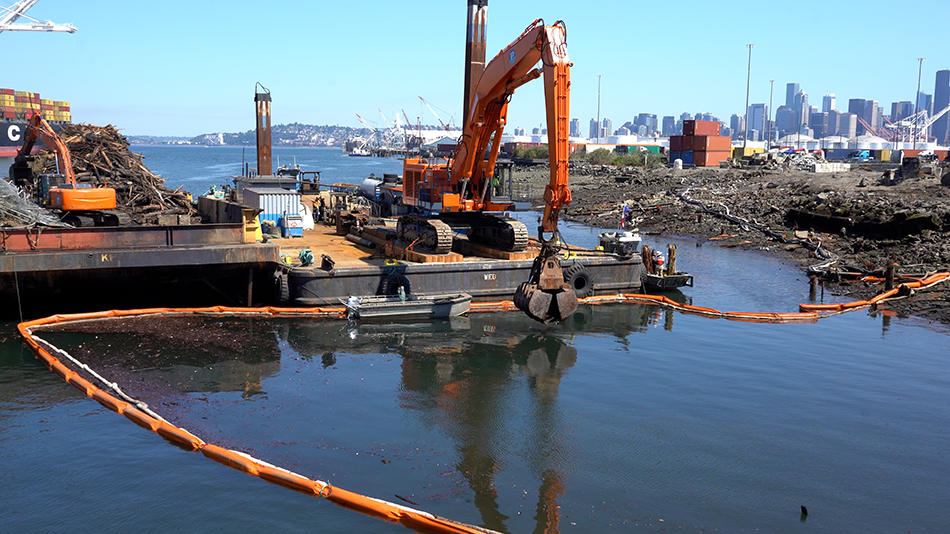King County is removing nearly 2,000 toxic-coated pilings from the Harbor Island shoreline, improving habitat for marine life in the Duwamish River
Summary
The King County Solid Waste Division is removing a derelict timber dock from the mouth of the Duwamish River, supporting a regional effort to clean up historic pollution and restore shoreline and aquatic habitat.
Story

King County is conducting a major cleanup project where the Duwamish River meets Elliott Bay, removing a derelict timber dock and nearly 2,000 toxic-coated pilings from the Harbor Island shoreline.
The $8.1 million project, led by King County’s Solid Waste Division, is removing a 72,700 square-foot dock and its 1,800 timber pilings coated in creosote, a chemical once used to preserve wood that is harmful to water quality and marine life. It contributes to a regional partnership committed to cleaning up historic pollution in the industrial corridor of the Duwamish River.
“Improving water quality where the river meets Elliott Bay builds on the progress we are making upstream to revitalize the Green-Duwamish Watershed for people, fish, and wildlife,” said Executive Constantine. “Removing nearly 2,000 contaminated creosote timber pilings from the Duwamish River will produce immediate and lasting benefits for marine life.”
Crews used heavy machinery aboard a barge to pull most of the pilings from the riverbed for safe disposal offsite. Broken pilings that could not be extracted will be cut off and removed with the help of divers excavating around the pilings. After completing in-water work, crews will remove the concrete bulkhead and other dock components on land and stabilize the shoreline. The project is scheduled to be completed by the end of September.
Crews will also install an environmental cap of clean gravel on top of the areas where the pilings were seated in the riverbed.
King County coordinated with local, state, and federal regulatory agencies to reduce impacts on water quality and the surrounding environment throughout the project. The county also worked with Tribes to minimize potential effects on local salmon populations, including pausing all construction during tribal salmon fisheries.
“The opportunity to directly and immediately improve the water quality of the Duwamish River and Elliott Bay is something we have embraced,” said Pat McLaughlin, Director of King County’s Solid Waste Division. “A complicated cleanup project on this scale requires highly trained professionals operating large machinery on open water, and our staff and partners delivered.”
King County partnered with contactors Pacific Pile & Marine LP and KPFF to plan and execute the project.
Improving habitat at the mouth of the Duwamish River builds on King County’s numerous projects throughout the Green-Duwamish Watershed, including the successful habitat restoration at a site now known as čakwab, pronounced “chock-wob.” King County’s Wastewater Treatment Division, meanwhile, is completing a new station in Georgetown that will better protect the Duwamish River and Puget Sound from polluted stormwater as the region experiences more severe rain events due to climate change.
The Department of Natural Resources and Parks has created an interactive map that tracks environmental stewardship throughout King County.
Relevant links
- PHOTO GALLERY: Removing pilings from Harbor Island shoreline
- VIDEO: B-roll package of dock and piling removal
- King County Harbor Island Dock Demolition Project
- TRACKS: An interactive map tracking progress on environmental stewardship
Quotes
Improving water quality where the river meets Elliott Bay builds on the progress we are making upstream to revitalize the Green-Duwamish Watershed for people, fish, and wildlife. Removing nearly 2,000 contaminated creosote timber pilings from the Duwamish River will produce immediate and lasting benefits for marine life.
The opportunity to directly and immediately improve the water quality of the Duwamish River and Elliott Bay is something we have embraced. A complicated cleanup project on this scale requires highly trained professionals operating large machinery on open water, and our staff and partners delivered.
For more information, contact:
Annie Kolb-Nelson, Solid Waste Division, 206-477-5373

 Translate
Translate